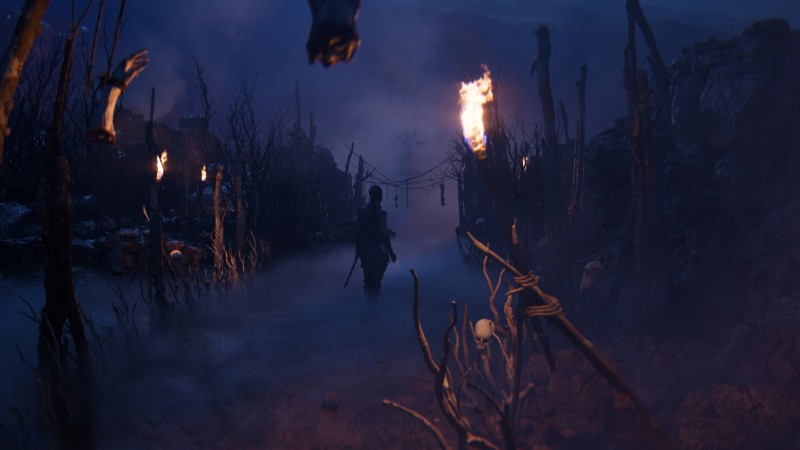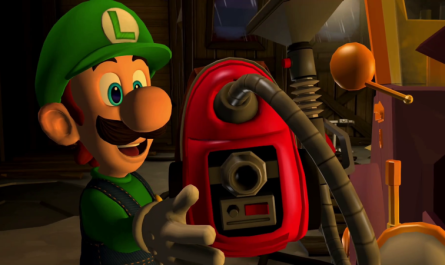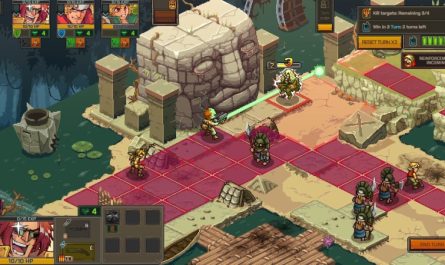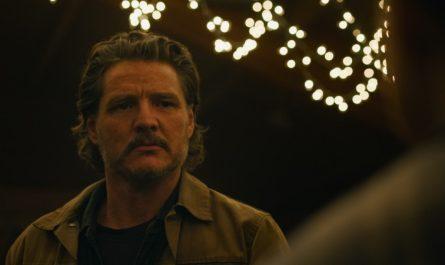Reviewed on:
Xbox Series X/S
Platform:
Xbox Series X/S, PC
Publisher:
Xbox Game Studios
Developer:
Ninja Theory
Release:
May 21, 2024
Rating:
Mature
Hellblade: Senua’s Sacrifice didn’t need a sequel. It had a clear story to tell, and it told it well with an artful (and tactful) execution of its mental health themes and a strong conclusion. But Senua’s Saga: Hellblade II builds a great case for itself by using the titular warrior’s growth to help not only herself but, for the first time, others around her, shining her in a fascinating new light. Refined gameplay and a jaw-dropping presentation make for a more wholly satisfying sophomore outing.
Since the first game’s conclusion, Senua’s a little older, a little wiser, and has more confidence in herself. Although the psychosis-induced voices in her head still pepper her every thought (headphones are highly recommended due to the fantastic and effective 3D audio), she’s largely embraced and accepted them. This time, the voices factor less directly into gameplay and are largely used as an effective storytelling flourish: audible manifestations of her innermost thoughts and anxieties.
Senua’s journey takes her to a new land to put an end to the slavers that ravaged her homeland. As that story evolves into something far grander and fantastical, I enjoyed the new emphasis on companionship. Melina Jurgens delivers another phenomenal performance as Senua, and she’s backed by an equally impressive supporting cast. Seeing Senua interact and travel with a small cast of likable and interesting allies and use the lessons learned from her struggles to help them overcome their own darkness is rewarding. Not only does it feel like satisfying growth, but her relatable fears of leading them astray add a nice dimension to her already compelling character. Watching Senua combat old demons as they rear their heads again is also a realistic and refreshing portrayal of the constant battle that is mental health; her triumph in the first game wasn’t, and shouldn’t be, a one-time victory.
The adventure feels more digestible and coherent from a mainstream sense as she tackles an exciting and disturbing pantheon of deadly giants. The first game told a small, intimate story, but this tale feels closer to an epic without losing its pensive element. With a roughly seven-hour runtime, the story wisely doesn’t overstay its welcome and, like the first game, feels focused. You’re here for a good, emotional time, not a long one.
However, now that Senua has companions to banter with, the voices she hears have an unfortunate habit of speaking up over crucial dialogue. From an artistic standpoint, and I say this as someone who has never experienced psychosis, trying to tune them out to concentrate on a conversation helped me empathize with Senua’s day-to-day experience. But as a game, the voices’ constant chatter did prove a genuine hindrance when I wanted to listen to someone else. When the game does try to separate the two, it occasionally creates an awkward conversation cadence with strange, ill-fitting pauses during talks to fit in a flurry of inner voice dialogue.
The intimate one-on-one combat encounters remain largely the same but with a dazzling visual and cinematic upgrade, minus some old annoyances. Enemies no longer blindside you from off-screen, meaning the action stays in front of you at all times. Sword duels remain a repetitive but entertaining dance of dodging powerful swings and nailing satisfying parries to fill a time-slowing focus meter that, once unleashed, allows Senua to briefly execute an unimpeded assault. While I enjoyed cutting down equally armed foes, the game admirably mixes up the enemy variety with challenging threats that scurry on their hands erratically or, most annoyingly, spew fire. Dodging the latter’s flame-based offense proved visually tricky to evade, so I often cheesed them and other nuisances by activating my focus to quickly drop them as soon as they took the field. Ninja Theory thankfully axed the first game’s creeping permadeath penalty, so dying here has no consequence, and you’re quickly thrown back into the action.
Taking down threats leads to seamless and varied transitions to the next foe, making fights feel like an interactive cinematic in the most complimentary way. This is just a microcosm of the game’s incredible production values; Hellblade II is arguably the most beautiful game I’ve ever played. From fantastic, subtle facial animations to the superb lighting of its idyllic landscapes and the nightmarish designs of the Norse adversaries, Hellblade II is one of the few titles that truly looks next-gen. Best of all, the presumed increase in budget doesn’t result in a mere increase in fidelity. The creative artistic touches of the first game remain intact and dialed to eleven, with mind-bending kaleidoscopic effects and dreamlike lighting and visuals. Hellblade II isn’t just technically impressive; it’s genuinely alluring to stare at as an art piece.
Exploring this stunning world is also more fun, thanks to the increased puzzle variety. The perspective-based “spot the sigil in the environment” riddles, which were enjoyable but overused in the last game, are dramatically reduced in number and spread more evenly throughout the adventure. Other challenges, such as solving illumination puzzles to navigate a dark, terror-filled cave or building paths using world-shifting magic, are adequately entertaining and make for a more well-rounded journey. Venturing beyond the generally linear paths to uncover secret totems or mystical trees that spin fragmented yarns is fun, even if the idea conceptually clashes with the otherwise narrative-focused treks. It’s tough to focus on a given conversation when I’m anxious to break away and inspect every nearby surface for a hidden path.
Senua’s Saga: Hellblade II’s conclusion ends on another strong note, and despite my initial reservations about continuing Senua’s story, I walked away happy to see her conquer new monsters, both literal and metaphorical. I’m pleased Ninja Theory avoided the temptation to blow up this formula into something far bigger than needed – this isn’t Xbox’s God of War; it’s a better Hellblade. The first game is a famous example of not needing to be fun in the traditional sense to be engaging. This sequel sprinkles more broadly appealing thrills while retaining the thoughtful storytelling and artistry few triple-A games possess.
Score:
9
About Game Informer’s review system
PurchaseReviewed on:
Xbox Series X/S
Platform:
Xbox Series X/S, PC
Publisher:
Xbox Game Studios
Developer:
Ninja Theory
Release:
May 21, 2024
Rating:
Mature
Hellblade: Senua’s Sacrifice didn’t need a sequel. It had a clear story to tell, and it told it well with an artful (and tactful) execution of its mental health themes and a strong conclusion. But Senua’s Saga: Hellblade II builds a great case for itself by using the titular warrior’s growth to help not only herself but, for the first time, others around her, shining her in a fascinating new light. Refined gameplay and a jaw-dropping presentation make for a more wholly satisfying sophomore outing.
Since the first game’s conclusion, Senua’s a little older, a little wiser, and has more confidence in herself. Although the psychosis-induced voices in her head still pepper her every thought (headphones are highly recommended due to the fantastic and effective 3D audio), she’s largely embraced and accepted them. This time, the voices factor less directly into gameplay and are largely used as an effective storytelling flourish: audible manifestations of her innermost thoughts and anxieties.
Senua’s journey takes her to a new land to put an end to the slavers that ravaged her homeland. As that story evolves into something far grander and fantastical, I enjoyed the new emphasis on companionship. Melina Jurgens delivers another phenomenal performance as Senua, and she’s backed by an equally impressive supporting cast. Seeing Senua interact and travel with a small cast of likable and interesting allies and use the lessons learned from her struggles to help them overcome their own darkness is rewarding. Not only does it feel like satisfying growth, but her relatable fears of leading them astray add a nice dimension to her already compelling character. Watching Senua combat old demons as they rear their heads again is also a realistic and refreshing portrayal of the constant battle that is mental health; her triumph in the first game wasn’t, and shouldn’t be, a one-time victory.
The adventure feels more digestible and coherent from a mainstream sense as she tackles an exciting and disturbing pantheon of deadly giants. The first game told a small, intimate story, but this tale feels closer to an epic without losing its pensive element. With a roughly seven-hour runtime, the story wisely doesn’t overstay its welcome and, like the first game, feels focused. You’re here for a good, emotional time, not a long one.
However, now that Senua has companions to banter with, the voices she hears have an unfortunate habit of speaking up over crucial dialogue. From an artistic standpoint, and I say this as someone who has never experienced psychosis, trying to tune them out to concentrate on a conversation helped me empathize with Senua’s day-to-day experience. But as a game, the voices’ constant chatter did prove a genuine hindrance when I wanted to listen to someone else. When the game does try to separate the two, it occasionally creates an awkward conversation cadence with strange, ill-fitting pauses during talks to fit in a flurry of inner voice dialogue.
The intimate one-on-one combat encounters remain largely the same but with a dazzling visual and cinematic upgrade, minus some old annoyances. Enemies no longer blindside you from off-screen, meaning the action stays in front of you at all times. Sword duels remain a repetitive but entertaining dance of dodging powerful swings and nailing satisfying parries to fill a time-slowing focus meter that, once unleashed, allows Senua to briefly execute an unimpeded assault. While I enjoyed cutting down equally armed foes, the game admirably mixes up the enemy variety with challenging threats that scurry on their hands erratically or, most annoyingly, spew fire. Dodging the latter’s flame-based offense proved visually tricky to evade, so I often cheesed them and other nuisances by activating my focus to quickly drop them as soon as they took the field. Ninja Theory thankfully axed the first game’s creeping permadeath penalty, so dying here has no consequence, and you’re quickly thrown back into the action.
Taking down threats leads to seamless and varied transitions to the next foe, making fights feel like an interactive cinematic in the most complimentary way. This is just a microcosm of the game’s incredible production values; Hellblade II is arguably the most beautiful game I’ve ever played. From fantastic, subtle facial animations to the superb lighting of its idyllic landscapes and the nightmarish designs of the Norse adversaries, Hellblade II is one of the few titles that truly looks next-gen. Best of all, the presumed increase in budget doesn’t result in a mere increase in fidelity. The creative artistic touches of the first game remain intact and dialed to eleven, with mind-bending kaleidoscopic effects and dreamlike lighting and visuals. Hellblade II isn’t just technically impressive; it’s genuinely alluring to stare at as an art piece.
Exploring this stunning world is also more fun, thanks to the increased puzzle variety. The perspective-based “spot the sigil in the environment” riddles, which were enjoyable but overused in the last game, are dramatically reduced in number and spread more evenly throughout the adventure. Other challenges, such as solving illumination puzzles to navigate a dark, terror-filled cave or building paths using world-shifting magic, are adequately entertaining and make for a more well-rounded journey. Venturing beyond the generally linear paths to uncover secret totems or mystical trees that spin fragmented yarns is fun, even if the idea conceptually clashes with the otherwise narrative-focused treks. It’s tough to focus on a given conversation when I’m anxious to break away and inspect every nearby surface for a hidden path.
Senua’s Saga: Hellblade II’s conclusion ends on another strong note, and despite my initial reservations about continuing Senua’s story, I walked away happy to see her conquer new monsters, both literal and metaphorical. I’m pleased Ninja Theory avoided the temptation to blow up this formula into something far bigger than needed – this isn’t Xbox’s God of War; it’s a better Hellblade. The first game is a famous example of not needing to be fun in the traditional sense to be engaging. This sequel sprinkles more broadly appealing thrills while retaining the thoughtful storytelling and artistry few triple-A games possess.
Score:
9
About Game Informer’s review system
PurchaseRead MoreGame Informer



